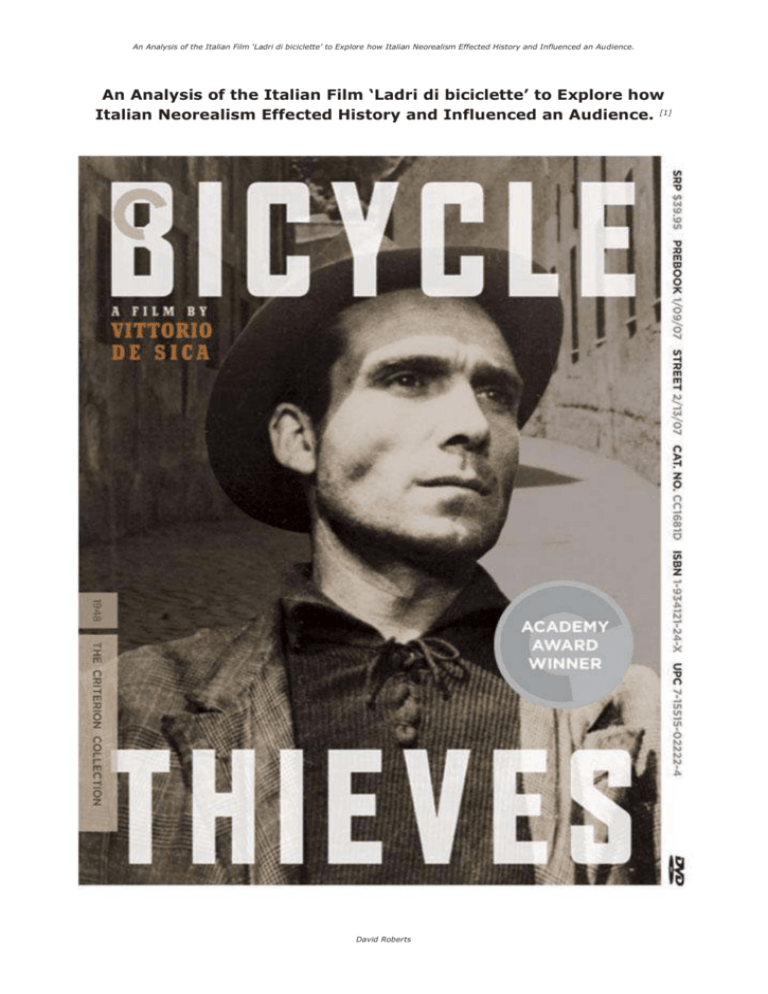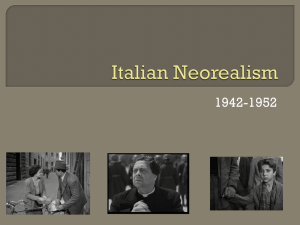An Analysis of the Italian Film 'Ladri di biciclette'
advertisement

An Analysis of the Italian Film ‘Ladri di biciclette’ to Explore how Italian Neorealism Effected History and Influenced an Audience. An Analysis of the Italian Film ‘Ladri di biciclette’ to Explore how Italian Neorealism Effected History and Influenced an Audience. [1] David Roberts An Analysis of the Italian Film ‘Ladri di biciclette’ to Explore how Italian Neorealism Effected History and Influenced an Audience. In this analysis I am going to explore Vittorio De Sica’s film ‘Ladri di biciclette’ (‘Bicycle Thieves’) [Italy, 1948, Vittorio De Sica] and look at how the ideas and themes in this Neo-realistic film were created, as well as looking at the Italian historical context of the time and the effect this film and similar films had on audiences. This film is regarded as the best example of neo-realism and was heralded in early polls by Sight and Sound as the best movie ever made.[2] Neo-realist films were created in post-war 1940s Italy and showed a gritty and difficult world. Shot on location with handheld cameras these grainy films used non-actors improvising dialogue much like a documentary would be made. There was never an aim for perfection. The academy award winning[3] Bicycle Thieves is a classic piece of black and white world cinema. It explores the life of Antonio Ricci in a ‘realist’ way as he endeavours to reclaim his bike so he can get back to work. The film uses very simple and everyday occurrences to create a realistic plot and uses raw emotion to portray the meaning of film to the spectator. The film contains all the neo-realist conventions; the film was shot on location in Lazio[4] with handheld cameras using non-actors[5] Lamberto Maggiorani and Enzo Staiola to portray the lead roles. The scene I have chosen to analyse is the scene from 01:19:00:00 to 01:24:00:00 where the father steals a bike from a side street and gets chased by a crowd of people in the road and caught and his son chases after him crying. They are then humiliatingly walked hand in hand, away to the police. David Roberts An Analysis of the Italian Film ‘Ladri di biciclette’ to Explore how Italian Neorealism Effected History and Influenced an Audience. To me this is the most dramatic and intense part of the film. In this scene we get to see an emotionally erratic son chase after his father because he sees people shouting at him and barging him. What I find incredible is these non-actors are able to display through their body language great emotions and ideas. You really feel sorry for the son when you see the worried expressions painted across his face and the tears and sadness. There are some terrific shots in this scene but I can only surmise that they are accidental because most neo-realistic films are improvised. There is a fantastic shot as the camera pans past the son and he looks on gloomily at was is happening. The camerawork is similar to the motion of the bike so I believe the audience is to assume the boy is looking at his father. He looks almost angry but worried at the same time. The camerawork though is shaky, with handheld cameras following the action round at a rapid pace much like a documentary piece of footage would. This psychologically tells us this is realistic because we have such strong ties with this style of camerawork being in factual documentaries and the news. It also keeps the action moving and doesn’t let the film stop. Things go in front of the camera like a busy crowds and bikes as if it was filmed in a real city. The location here shows a city in ruin with people in ripped and dirty clothes in the miseen-scene. This helps reinforce the idea of poverty in Italy at the time and helps to David Roberts An Analysis of the Italian Film ‘Ladri di biciclette’ to Explore how Italian Neorealism Effected History and Influenced an Audience. highlight where we are in history and why the man is so desperate to get a job. The damage in the mise en scene on characters clothes, in the street, the scenery and even how bad people’s equipment and materials possessions are help to get across the ideas that this place is poverty stricken. It also has a mean streak of somewhat showing the barbarity of poverty. In the film is this man driven to steal and commit crimes, the situation somewhat having an effect of saying when you’re this low down and this poor you look after your own, and don’t care about anybody else. It also demonstrates ideas of violence and crime in Italy at the time, which obviously in a post war poverty stricken country was extremely high. Throughout the film clues and themes of high crime are very present including the scene in the police station where many wanted posters are up on the wall. There isn’t much speech in this scene, just a limited conversation between father and son and the crowd of people shouting at him when he steals the bicycle. The acting here works on physical portrayal and facial expressions rather than dialogue. There is some music in the scene, but not a great deal which I believe helps to portray the quiet loneliness the pair feels in the world. The music sounds like an orchestra and seems to incur danger with its sharp notes. They feel isolated from society, outcast, and the sombre quietness allows us to empathise with the characters. The sound in the scene is probably all what was recorded whilst filming as it consists of only crowd noises and traffic. This helps bring another dimension of realism to the film. A big idea the film, and this scene particularly, uses is the staring of eyes to convey emotion. The actors are very good at this surprisingly and there are many close ups of the characters looking in the other characters direction in a certain ways and their faces and eyes portray an emotion allowing them to act without even speaking. The film also contains a logic that shows how contradictory and messed up life can be. The man needs a job because he has no money, but to get a job ne needs a bicycle, a bicycle costs money which he surely can’t afford. The films displays here a real life David Roberts An Analysis of the Italian Film ‘Ladri di biciclette’ to Explore how Italian Neorealism Effected History and Influenced an Audience. occurrence that happens all the time in 1940s Italy where something simplistic can stop someone dead in their tracks before they have even had a chance to start. To me what makes this film work is the chemistry between the two actors which crates one of the most believable father and son partnerships in film history. They genuinely looks emotionally attached to each other and bring and fantastic performances that make you believe in them and feel sorry for them. Though it is a sorry story about the relationship between a father and son it is also a social commentary of the time and displays a man desperate to reclaim his spot as breadwinner for the family because his manhood and dignity has been taken away and they are poor. But even at the end of the film, like often in real life, there is no happy ending and he is further embarrassed in the street in front of his own son stripping away further masculinity from the father. And that is what anti-Hollywood neo-realistic films are all about. There are no happy endings. Neo-realistic films were a product of a country in a difficult economic state and whose psychological moral had been destroyed after the Second World War. The everyday lives of ordinary citizens had been completely changed and once self-sufficient families were now confined to poverty. This desperate and dark world was transplanted onto the screen by many filmmakers of the time creating a tough, gritty cinema. The new Italian David Roberts An Analysis of the Italian Film ‘Ladri di biciclette’ to Explore how Italian Neorealism Effected History and Influenced an Audience. directors were influenced by documentaries to create a realistic view on the story opposed to the fantasy based Hollywood films popular at the time. The reason Italy got into this state was the Second World War. Prior and during the war Italy was under the fascist dictatorship of Mussolini and allied themselves with Nazi Germany. After defeat in World War 2 and a revolt in Italy Mussolini was executed publicly and the country returned to democratic rule. However the war had created huge losses and damage and left the country in a mess that was hard to clear up. The country had however a well-developed studio system with excellent studios and big attendances at cinemas. Most films that had been made were propaganda films and costume epics. After the war left winged political ideals started to take storm in the country and a new national cinema emerged that embraced realism and opposed Hollywood. They aimed to create films about working-class people in small towns depicting everyday events whilst promoting politically socialist ideals. Critics say the films relied on creating emotions and the political propaganda makes the films unrealistic and superficial. The films failed after a few years because Italian audiences didn’t respond to the films and the political ideals of the country swung to the right again. After this a new generation of Anti-realism directors emerged opposing their predecessors. They did however influence Hollywood who created more realistic films in the late 40s and future filmmakers, especially documentary filmmakers and British New Wave directors, liked to copy this style. David Roberts An Analysis of the Italian Film ‘Ladri di biciclette’ to Explore how Italian Neorealism Effected History and Influenced an Audience. In all The Bicycle Thieves is a great example of a neo-realistic film that helps to portray the historical picture of Italy at the time. De Sica’s film helps portray the poverty stricken nation and its problems with it high levels of crime with a highly emotive and realistic performance with great realistic cinematography to create a truly masterful piece of Italian cinema. By David Roberts Student Number: 30001220 Word Count: 1,401 David Roberts An Analysis of the Italian Film ‘Ladri di biciclette’ to Explore how Italian Neorealism Effected History and Influenced an Audience. Footnotes [1] Ladri di biciclette; aka Bicycle Thieves [Italy, 1948, Vittorio De Sica] [2] http://rogerebert.suntimes.com/apps/pbcs.dll/article?AID=/19990319/REVIEWS08/903190306/1023 [3] http://www.imdb.com/title/tt0040522/awards [4] http://www.imdb.com/title/tt0040522/locations [5] http://www.imdb.com/title/tt0040522/trivia Filmography · Ladri di biciclette; aka Bicycle Thieves [Italy, 1948, Vittorio De Sica] Webography · Roger Ebert, Chicago Sun Times – Great Movies, at http://rogerebert.suntimes.com/apps/pbcs.dll/article?AID=/19990319/REVIEWS08/903190306/1023 (accessed 08th January 2011) · IMDB, Bicycle Thieves at http://www.imdb.com (accessed 12th January 2011) David Roberts







